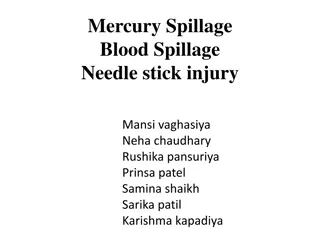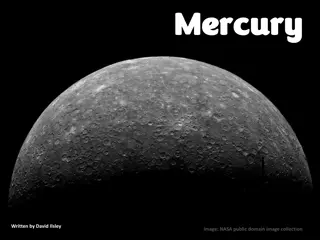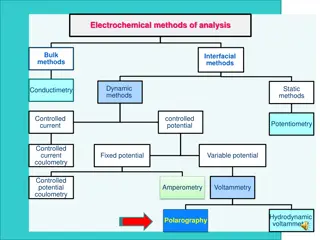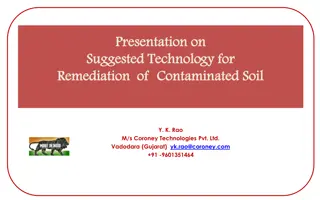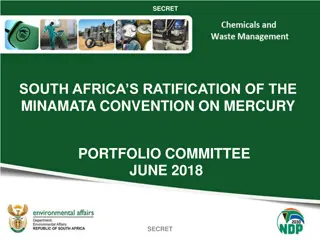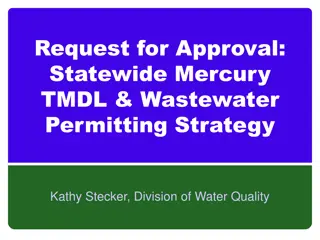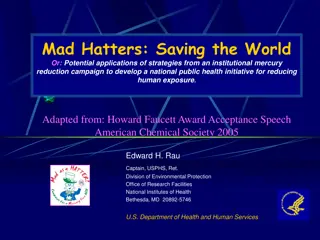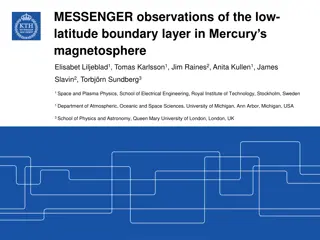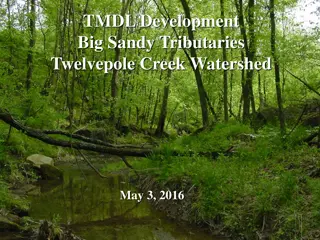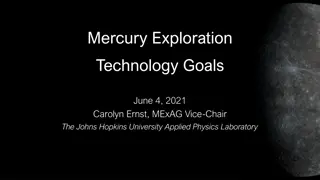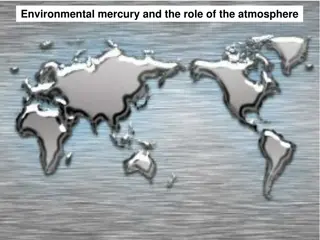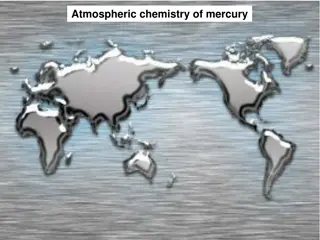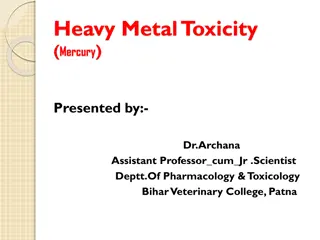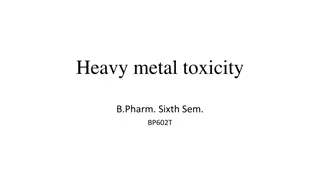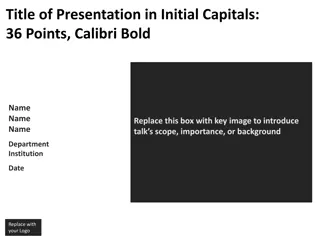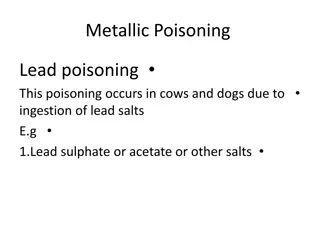Mercury TMDL Review and Permitting Strategy Update for Water Quality Protection
Reviewing the Total Maximum Daily Load (TMDL) of mercury in water bodies, its impacts on aquatic life and human health, and strategies for permitting to ensure compliance with environmental standards. Includes an overview of mercury sources, regulatory approvals, reduction targets, and monitoring components for effective pollution control.
Download Presentation

Please find below an Image/Link to download the presentation.
The content on the website is provided AS IS for your information and personal use only. It may not be sold, licensed, or shared on other websites without obtaining consent from the author. Download presentation by click this link. If you encounter any issues during the download, it is possible that the publisher has removed the file from their server.
E N D
Presentation Transcript
Mercury Mercury TMDL Review TMDL Review & Permitting & Permitting Strategy Update Update Strategy Jeff Poupart Water Quality Permitting Section Chief Division of Water Resources
Mercury TMDL Review Background Mercury affects nerve cells in the brain and spinal cord Persistent in environment, bioaccumulative NC DHHS statewide fish consumption advisory for largemouth bass Not just a NC problem Atmospheric deposition significant mercury source
Mercury TMDL Review Total Maximum Daily Load Section 303(d) of Federal Clean Water Act NC Statewide Mercury TMDL Approved by EMC - September 13, 2012 Wastewater Permitting Strategy also approved by EMC Approved by EPA - October 12, 2012
Mercury TMDL Review NC statewide mercury TMDL 2002 = baseline year TMDL target = 0.3 mg/kg mercury in fish tissue 12 ng/l is aquatic life criterion, not human health 67% reduction in total mercury loading needed Wastewater sources have met reduction NC air sources expected to meet by 2016
Mercury TMDL Review In NC Atmospheric deposition = 98%, wastewater = 2% In-state air 16%, out-of-state air 84% TMDL provides statewide aggregate load for mercury in wastewater = 81 lbs/year TMDL + permitting strategy ensure mercury contributions from wastewater remain low
Permitting Strategy Update Strategy Components Monitoring Reasonable potential analysis Water quality-based limits Mercury Minimization Plans Technology-based maximum 47 ng/l
Permitting Strategy Update How and who gets limits, MMPs Look for effluent sampling values >47ng/L Look for average sampling >12ng/L, taking upstream into account If neither, monitoring only Perform Reasonable Potential Analysis Based on Instream Waste Concentration of discharge into river Facilities that do receive a limit will be phased approach first 4 yrs of 5 yr permit
Permitting Strategy Update Mercury Minimization Plans Best Management Practice Acceptable alternative to WQBELS in most cases Preferable to very low facility-specific permit limits Template developed in stakeholder process Customizable, flexible Low administrative burden results every 5 years Other states require MMPs for smaller facilities
Permitting Strategy Update Mercury Minimization Plans for >2MGD Look for values>Practical Quantitation Level (PQL) Mercury is tested using EPA Method 1631E PQL ~0.5ng/L Permitting strategy requires MMP whenever there is consistent detectable mercury MMP also required if permitee had a limit for mercury
Permitting Strategy Update Since January 2013 DWR has issued 444 permits 80 Majors/364 Minors (57 w/ permitted flow >2 MGD) 41 permits with Mercury Minimization Plan required 37 w/ permitted flow >2 MGD 46 w/ mercury limits or monitoring 19 Majors/27 Minors (13 w/ permitted flow >2 MGD) 34 w/ monitoring requirement 12 w/ permit limits
Permitting Strategy Update Impact on wastewater permits Less frequent monitoring Fewer facilities with limits More mercury minimization plans Lower costs overall Why? TMDL documents source contributions TMDL provides statewide allocation for wastewater
Questions? Permitting: jeff.poupart@ncdenr.gov TMDL: kathy.stecker@ncdenr.gov
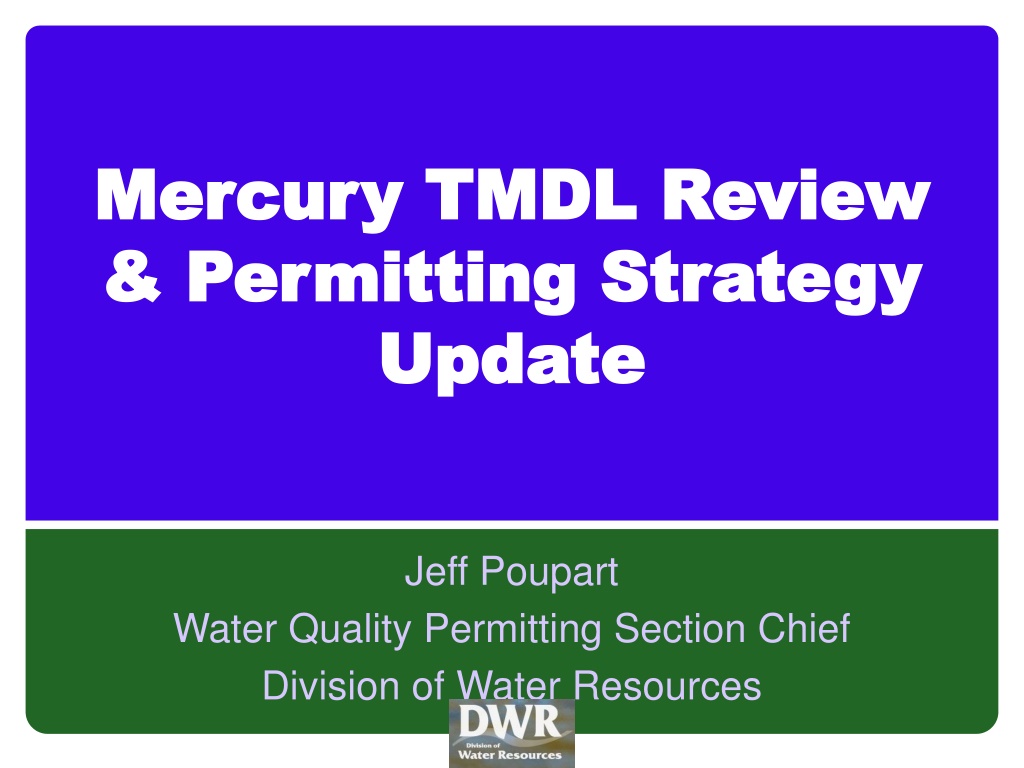

![[PDF⚡READ❤ONLINE] Planet Mercury: From Pale Pink Dot to Dynamic World (Springer](/thumb/21549/pdf-read-online-planet-mercury-from-pale-pink-dot-to-dynamic-world-springer.jpg)



